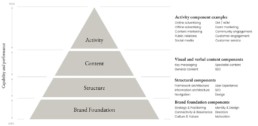The anatomy of a successful website
Much like building a physical house, there are four essential and interlocking components in a successful website; the Foundation, the Structure, the Content and the Human Activity that goes on both within and around the perimeter of the website.
The most successful and sustainable websites have all components functioning at the higher end of their potential. This is the sweet spot with the greatest benefits and returns on investment.
When discussing web development (as we are here) we’re generally talking about the design and creation of structure and content. These are two pieces of a four piece puzzle – so while absolutely crucial and fundamental, they are also ineffective without a solid brand foundation below it and engaging marketing activity feeding into it.



Brand Foundation
Optimised brand strategy & positioning.
Brand values and core purpose. Key messaging, brand identity and DNA. Brand guidelines and management.

Structure
Well designed framework (Structure, information architecture and hierarchy, navigation, user experience, engagement mechanisms) for both the user experience and Google SEO.

Content
Engaging and concise content – both visual and verbal communications – of your unique proposition in your unique character (aka brand content), plus content optimisation (search engine).

Activity
Marketing plan and activity. Advertising, social media and PR. Good business citizenship, contributing to and engaging with your community and networks. Customer engagement and service. Content marketing, back-linking and SEO.

Well designed and well built architecture
If you want to have a website that does well online then you have to play by the rules. The commercial side of the world wide web is heavily influenced by search engines and their ‘spider’ software that crawls the web ‘reading’, indexing and ranking. To do well online, it is essential that your website is formatted in best practice ways that makes it recognisable and readable to this technology. Good structure leads to higher ranking in Google.
Thankfully, in recent times, the algorithms have become so smart that Google and the likes reward genuine best practise site architecture, good user experience and quality content designed (by majority) for humans. So, very simply put, while there are certain frameworks to implement and maintain; good website and SEO framework is now more about being a good digital business citizen (being well ordered, serving a clear need and contributing to the ecosystem) than it is about tricking the system – as it has been in the past.

For a free high level review of your website and brand contact grant@creativedept.co.nz
Engaging, concise and relevant content
Good communication and understanding in business is essential to success. And online communication is no different. It’s surprising how many businesses don’t understand this simple fact and how poorly they communicate – both verbally and visually – with the world.
Verbal communications
Imagine for a moment your website was your human sales rep. What is its tone of voice – how does it sound? Is it clear and concise – or vague, rambling or disjointed? Often websites try to offload far too much information on the reader all at once; the equivalent of a salesperson coming up to you and giving you their long winded pitch without you asking for it. Or telling you stuff you’re not interested in, not telling you enough, shouting at you or just being really boring.
People are busy and you can’t expect them to work for the information they’re looking for. It takes investment to get traffic to your site so once visitors are there you need to ensure your messaging and information pathways are both user friendly and effective. Websites that do this convert more traffic into business. Websites that don’t do this well lose a large percentage of their traffic and significant revenue.
As well as your human visitors, Google’s software now ‘understands’ more natural language than ever before, so your messaging can and should be natural, but must be very clear and well ordered to be utilised by Google.
Fundamentally and very simply put, Google’s job is to crawl, index and then rank web pages. It finds, filters and finally provides the best possible solutions and answers to search enquiries, some of which can be very specific. The relevence and quality of your website’s content leads to ranking which leads to traffic which leads to sales.
If you want to be found, get through the filters and served up as a solution to the requests then well written and ordered communications are mandatory.
Visual communications
…Then there’s how your digital sales rep looks; is the image they portray at bare minimum professional? Would you trust them – do they fill you with confidence? And maybe most importantly, are they genuine and relatable?
Graphic language (photography, iconography, videography, pictography, typography and graphics) is a massively undervalued medium. The old adage ‘a picture is worth a thousand words’ is true, good graphic language can communicate much of what you need to say in a matter of seconds. And when you’re competing for the attention of busy people, sometimes seconds are all you might have. Having the ability to get key messages across in seconds rather than minutes or hours, is incredibly valuable and should not be underestimated.
Like written language, graphic language is a fine art. To the untrained it might seem to be simply to do with cosmetics, but that’s far from the truth. It is a very powerful language, maybe more powerful than written language. Most don’t understand how to ‘write’ it cohesively but everyone’s decision making is heavily influenced by it – whether they realise it or not.
Today’s audience demands authenticity and transparency and brands that are cohesive, genuine and distinguished have a big advantage over generic, disjointed or characterless veneers. Being genuine and engaging pays dividends. It’s about relatability, memorability and connecting with your audience and there’s no better digital media than design, photography or videography to achieve this.
The Website Development Process
Web design and development happens over seven steps, each critical to the process. Successful web development is a thorough and methodical process. By taking the time to do each step right you’ll reap the rewards of a high performing website for years to come.
01: Formation of brief, project planning, research and strategy
We will discuss requirements, business objectives and how the website can provide the greatest value. We will work with you to define a brief, road-map the project and identify opportunities, challenges and solutions.
02: Planning site architecture
Develop the site architecture and taxonomy. Design blueprints of key pages demonstrating layout, section breaks and information architecture.
03: Content creation
Content (Copy, Photography, Graphics etc) needs to be created to populate the planned site. Often you will have some existing content that can be repurposed. We will assess this content, work out what fits the new aims and purposes and work with you to create new content.
04: Design
Design the look and feel of key pages demonstrating typography, colour palette, use of graphics, photography, iconography.
05: Development
Set up staging site including theme and plug-ins. Develop working HTML/CSS site to best practice web standards. Develop responsive pages for mobile and tablet experience. Build of entire site, add functionality such as forms, links and any third party add-ons. Set up SEO content.
06: Testing, quality assurance and go live
Website tested on all popular operating systems. Device testing, tablets, phones, desktop. Form submission testing. Final checks before go live.
07: Hosting, security, maintenance and care
Managed hosting includes a regular backup schedule, updates to CMS and plug-ins to protect the website. Integrate Google analytics.
Website development FAQ’s
The short answer is, it should cost less than it’s going to make. Ideally a lot less. And make a strong and sustainable return on investment.
In terms of actual dollars, there’s no easy answer to this one sorry. It depends upon a number of variables such as:
- what your needs are,
- what assets you already have,
- what content needs to be created,
- the size of the website.
Broken down further this relates to the quality and quantity requirements of:
- the branding,
- site and information architecture,
- copywriting,
- design,
- photography,
- development,
- SEO and other functionality.
A lack of transparency, significant variations in the quality of product and technical jargon often makes choosing a web developer a difficult task. Be wary of web developers who will narrow the scope in order to provide a cheaper quote and false economies. This will cost you in the short term through scope creep or in the long term through loss of revenue due to poor performance, remedial work or the need to rebuild. A good proposal should cover the project holistically, be totally transparent and very clearly define what is and what is not included.
Websites – like cars – can be generalised into four categories. (We just do numbers 2 & 3).
1. Pieces of junk that are very cheap upfront but break down often and perform poorly.
2. Economical, efficient vehicles that get you from A to B and do the basics exceptionally well.
3. High performance, efficient and hard working vehicles.
4. Overpriced over-engineered show-pony cars.
And just like with cars, there are areas where you can overspend and areas where you can underspend. If you’re comparing cost estimates, it’s important to assess whether apparent savings are good value or just a lesser product with less productivity and returns. And conversely whether more expense and investment represents greater productivity and returns.
What’s actually more important than upfront cost is finding a website design company that is honest, trustworthy, conscientious and genuinely takes pride in producing robust, high quality websites that are good value and serve the objectives of the business.
Mostly we prefer WordPress. Often mistaken as an amateur CMS, it’s actually a very high performance open-source publishing platform. While there are plenty of amateurs creating horrible websites with WordPress, it is also trusted to power many big brands. Sony Music, Fortune, TechCrunch, BBC America, The Whitehouse, The New York Times, Wired and TimeInc’s websites are all built on the Wordpress platform.
If you’ve only ever used a bare-bones install of WordPress, you may understandably think it has a terrible user experience. Set up properly however, with the right integrations, configuration and hosting, Wordpress is a world-class technology. Originally designed as (and still trying to shake the label of) a blogging platform, WordPress now has over 65,000 plugins available, which means it has remarkable flexibility and capability.
Another real benefit, is that it’s future-proof, and can easily adapt as your business needs change. Because it is extremely popular, it is also extremely well supported. If you need to integrate a payment gateway, autoresponder, analytics, or other third-party integrations such as Hubspot, you will have no issues. And, if you ever need to find someone to take over the management or development of your site, there is no shortage of WordPress technicians.
In terms of digital marketing capability, WordPress provides all of the tools. SEO, ability to create landing pages for ad campaigns, affiliate programmes, advanced tracking, testing, analytics, WordPress has it all covered and mastered.
For sites that need a lot of custom code we prefer Silverstripe. Silverstripe CMS is an open source CMS and Framework for creating and maintaining websites and web applications. Most sites however, do not need a lot of custom code.
With mobile traffic now exceeding desktop, having a website that delivers in a compelling way across all devices is essential. We design responsive websites that scale and resize to give users a consistently positive and engaging experience across all platforms.
We use specialist hosting that has bullet-proof security, managed patches and updates, performance analytics and lightning fast hosting. Utilising Amazon Web Services and Google Cloud Platform with global data centres and cloud coverage ensures your site is loading fast no matter where in the world your visitors are.
Information architecture is the art and science of creating a user-centric system of structuring complex information into a natural hierarchy with intuitive user flow.
We will set your site up with solid SEO fundamentals. Modern SEO for content marketing is predominantly about creating genuinely useful and engaging content – and quality rather than quantity. If you wish to pursue and invest in analysis, technical SEO and back-linking as a marketing strategy we can recommend a specialist agency to assist you with your ongoing Google ranking optimisation.
Yes we do. With every website we build we offer ongoing care plans. Just like cars, websites need occasional servicing and updating. The world wide web is a constantly evolving environment so a website needs to evolve along with it. It’s also fairly hostile environment, so it’s very important to keep the platform up to date with the latest updates, patches and plug-ins. We can provide training to assist you in using your website once it’s launched, and depending on need we can assist with content updates.